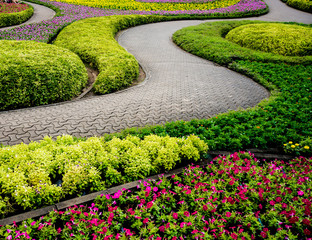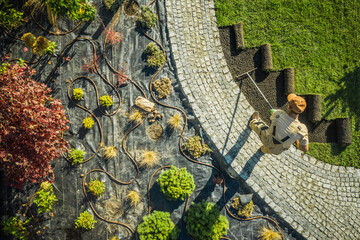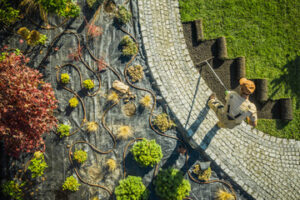Landscaping is the process of creating a visual appearance with plants, flowers, and other elements. It helps add value to your property and creates a pleasant environment for relaxation or entertaining.
The art of landscaping involves many important concepts, such as balance, rhythm, proportion, and unity. It also includes a thorough terrain assessment, design planning, and the integration of structural elements like pathways, patios, and water features. Visit https://www.ecograssnwa.com/ to learn more.
An irrigation system provides a consistent supply of water for the roots of plants and grass. It conserves water by avoiding overwatering, evaporation and runoff, and helps the landscape thrive. Irrigation systems are a critical tool for agriculture, landscaping and horticulture in regions with varying weather conditions and water availability.
Irrigation systems can include sprinklers, drip irrigation, or a combination of both. Each type of irrigation system is designed for specific uses and soil types. An irrigation consultant will determine the best irrigation design and system components to fit your landscape needs.
The irrigation controller (also called a timer) is the brain of the system. It controls the system’s watering schedule by opening and closing the valves that serve each individual “zone” of your yard. Each zone has its own start and run times. The size of your yard, soil type and plant types are also factors that affect how often and how much to water.
Water supply lines are the pipes that transport water from your irrigation meter to each sprinkler or drip emitter in your garden. These pipes are usually made of PVC or polyethylene for durability. They are generally installed underground to protect them from damage and to keep them out of sight.
Regular inspection and maintenance of irrigation systems can help prevent problems before they occur. Identifying issues like high water bills, poor plant health and pooling water can indicate that the system is leaking or in need of repair. Addressing these issues early on can reduce your water bill, save money and prevent future costly repairs.
Smart irrigation controllers use local weather and landscape information to create a customized watering schedule, optimizing your yard’s watering efficiency. These systems also eliminate the need for manual adjustments to match changing weather conditions and seasonal changes in watering requirements, saving you both time and water.
Irrigation audits are a great way to discover areas where you can improve your current watering practices and reduce waste. An audit can be as simple as an evaluation of your current watering habits or as comprehensive as a complete landscape analysis and report. Depending on your results, an irrigation expert can recommend improvements to optimize your watering practices and reduce wasted consumption.
Design
Landscaping involves designing, constructing, and maintaining outdoor spaces to create aesthetically pleasing, functional, and sustainable environments. Professional landscapers use their knowledge of horticulture, ecology, architecture, and environmental science to create balanced landscapes that integrate natural and man-made elements. Landscaping can range from simple plant arrangements to large-scale projects like the construction of outdoor features and walkways. Landscaping is often done for aesthetic purposes, but may also be used to solve problems such as soil erosion, water runoff, or poor drainage.
The different aspects of a landscape design include plants, trees, shrubs, flowers, soil, rocks, mulch, wood, and other decorative elements such as stone or bricks. A good landscaping design combines these elements in a cohesive manner that complements the style of the home or business. For example, a formal garden looks best with trimmed hedges while a more natural landscape works well with wildflowers and flowing plant beds.
In addition to creating a visual appeal, landscaping provides environmental benefits, such as reducing erosion, improving air quality, and providing habitats for wildlife. It can also add value to your property and make it more appealing to potential buyers.
There are several factors to consider when designing your landscape, including the size of your yard and the type of weather you experience in your area. In addition, you should choose plants and flowers that thrive in your climate and soil conditions. Landscaping requires regular maintenance, such as watering, pruning, and pest control. It also requires the use of special equipment, such as a lawnmower, fertilizers, mulch spreaders, and pruners.
The design of a landscape can be complicated, but it can also be very rewarding. To achieve the perfect look, you need to take into account your personal taste and preferences. A great way to start is by choosing a focal point, such as a fountain or a statue. Then, you can build around it with other accessories, such as outdoor furniture and lighting.
In addition to enhancing the appearance of your property, landscaping can increase its value and provide a comfortable space for family and friends to enjoy. Moreover, it can reduce noise pollution and enhance energy efficiency.
Installation
A landscaping project involves installing various elements to transform a bare outdoor space into a beautiful and functional area that enhances the property’s appearance and adds value. These projects often include hardscape and softscape features. Hardscape elements like walkways, patios, and decks are designed for aesthetic appeal, while softscape elements like plants, flowers, trees, and grass create a relaxing environment. Adding water structures like ponds and fountains to the landscape also gives it an attractive touch.
Landscaping can take many forms, ranging from a natural setting to a more formal garden with trimmed hedges and symmetrical plantings. It can also involve the use of rocks, mulch, wood, and other materials for decoration or functional purposes, such as erosion control or privacy screening. Regular maintenance is a key aspect of landscaping. This may include trimming, watering, and cleaning the landscaping area.
The installation of a well-designed and maintained yard is one of the best ways to increase the value of your home or commercial building. It also provides a comfortable place for your family and guests to relax and enjoy the outdoors. Professional landscapers use various techniques and elements to create a harmonious and visually appealing arrangement of elements. This includes ensuring that the landscape design reflects your style and theme, while taking into consideration the topography of your property and its use.
Whether you’re looking to create a lush green retreat or a more formal setting, a skilled landscaper can help you achieve your vision. The process begins with an initial consultation, where you meet with a landscaping expert to discuss your needs and goals. Site analysis is then performed, and a detailed landscaping plan is created. This plan will include everything from lawn installation to arranging flower beds and planting shade trees. It will also consider factors like soil quality, sunlight, and drainage to determine the ideal landscaping options for your property.
In addition to softscape features, landscaping can also include hardscape elements like patios and outdoor fireplaces. These structures are designed for comfort and leisure, and they can be a great addition to homes that do not have much outdoor living space. Landscapers also install outdoor lighting solutions, which are a great way to increase the security of your home while entertaining guests after dark.
Maintenance
Landscapers design and maintain outdoor spaces to enhance their appearance and function. This involves adding plants and modifying the terrain to create a more pleasing environment. Some of the most common landscaping features include flowers, trees, shrubs, lawns, and water systems. In addition, it can include a variety of hardscapes like paths and patios. Landscapers are also responsible for the design and installation of landscape elements that improve curb appeal and increase property value.
Unlike gardening, which has a more personal focus, landscaping is concerned with the aesthetics of an outdoor space and includes both plant selection and large-scale design features. Landscaping can be used to create a variety of styles, from natural and organic gardens with native plants to more formal designs using trimmed hedges. Landscaping can also include ornamental and functional structures, such as gazebos and pergolas, to add interest to the garden.
One of the most important aspects of landscaping is choosing plants that are suited to the climate and soil conditions where the landscaping will be located. This will reduce maintenance and watering needs, while also providing food and shelter to local wildlife. In addition, it is important to choose plants that complement the overall style of the landscaping. For example, a flower garden will look more polished when it is bordered by stone pathways or wood fences.
Landscaping can also include other features to improve the functionality of an outdoor space, such as patios, walkways, retaining walls, and fountains. These can be constructed from a variety of materials, such as concrete, bricks, and stones. Water structures can add a dramatic effect to any garden, and they are a great way to bring in sound and visual intrigue. Landscaping can also include artful accents, such as statues and decorative items that add personality to the garden.
Landscaping is a valuable investment that can improve the beauty and value of a home or commercial building. It can be done by professionals or by individuals, and it requires regular upkeep to keep it looking its best. A well-maintained landscape can be a source of pride and enjoyment for residents or guests of a property.





